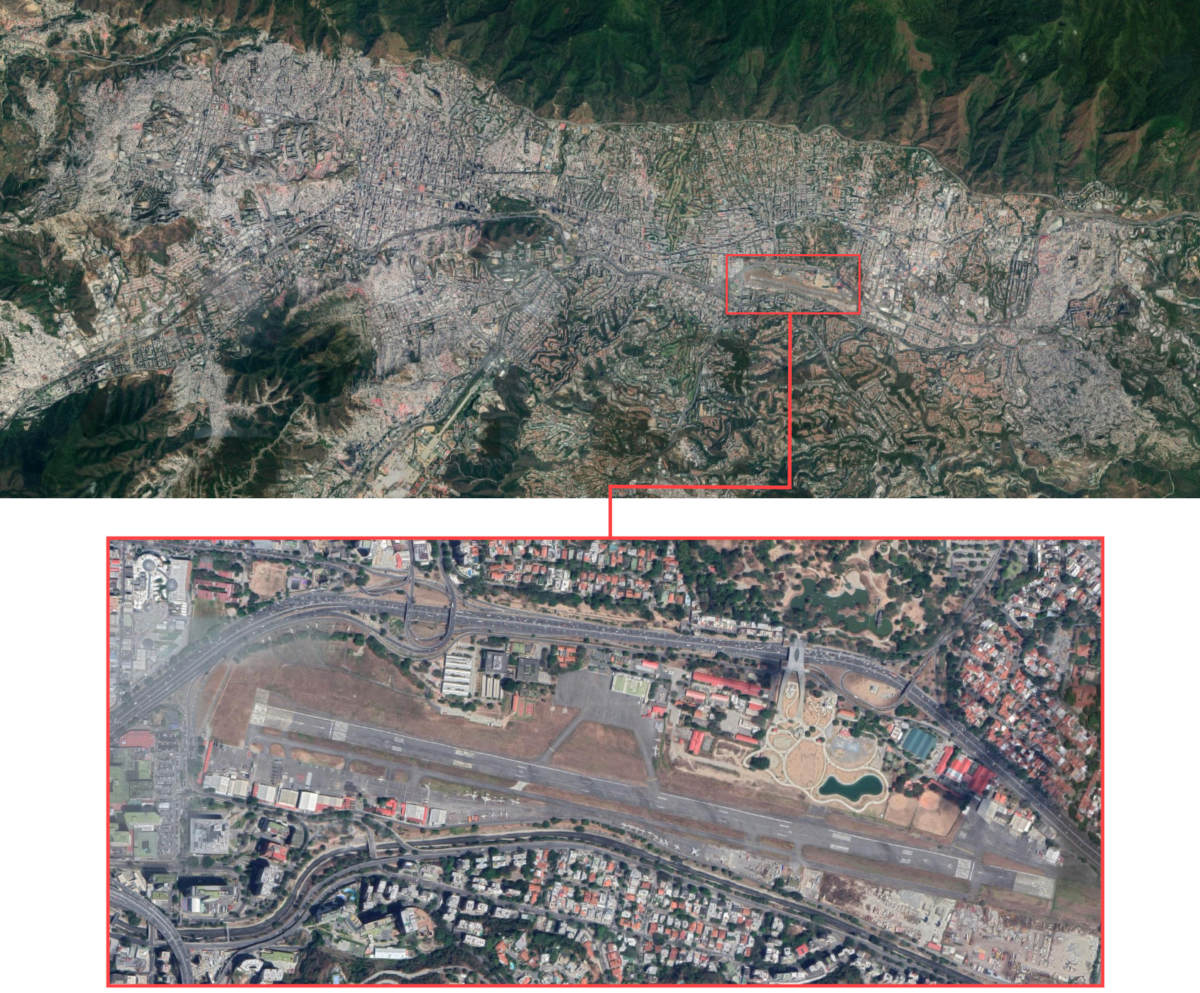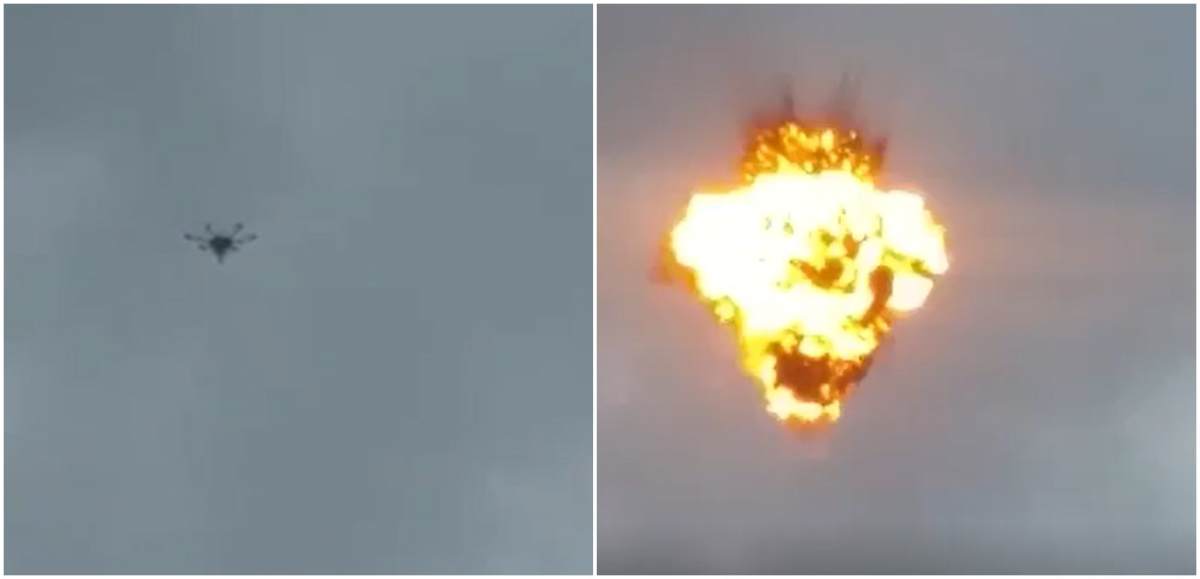“Operation Liberty”: Overview Of The “Definitive Phase” In Venezuela’s Political Crisis
All times appear as local time UTC-4.
Venezuelans awoke to a tumultuous morning on April 30, 2019. Leopoldo López, the leader of the Voluntad Popular [Popular Will, VP] party — under arrest since 2014 — had been freed. In a pair of messages shared on his Twitter account, López appeared beside National Assembly president Juan Guaidó, who claimed the title of interim president on January 23 of this year, along with a group of National Guard soldiers.
In the tweets, López and Guaidó called on Venezuelans to take to the streets in protest against the government of President Nicolás Maduro. Their goal: To force Maduro out of office that day.
A tense morning unfolded. Thousands of Venezuelans took to the streets of cities across the country, answering the call from opposition leaders. As the hours passed, the country waited for any sign that the National Bolivarian Armed Forces, long the backbone of the Maduro government, might be switching sides and joining the rebellion.
By day’s end, no such sign would come, and the political saga unfolding in Venezuela appeared to close another extraordinary chapter.
The events of that day appeared to take Venezuela on the brink of an explosive end to a months-long political stalemate underway since January, when Guaidó invoked the Venezuelan constitution to take on the role of interim president. Since that day, the Venezuelan opposition has been locked in an intense struggle against the Maduro government, one that has on occasion erupted into chaos, as it also did on April 30, 2019.
The Altamira Overpass
News of the insurrection broke via a video shared by Leopoldo López on his Twitter account. Posted at 5:46 a.m., the video features Juan Guaidó speaking to the camera before a group of National Guard soldiers. He calls on Venezuelans to “cover the streets” of the country, and to join him at the La Carlota air base to take part in the last push against the Maduro government, a plan which he called “Operation Liberty”:
Venezuela, lo estamos logrando ¡Fuerza y fe! https://t.co/aJqH7QKlkc
— Leopoldo López (@leopoldolopez) April 30, 2019
In a tweet sent at 6:17 a.m., López announced that he had been freed from captivity by soldiers loyal to Guaidó, that “the definitive phase” in the struggle against the Maduro government had come, and that it was “time to conquer freedom”:
Venezuela: ha iniciado la fase definitiva para el cese de la usurpación, la Operación Libertad. He sido liberado por militares a la orden de la Constitución y del Presidente Guaidó. Estoy en la Base La Carlota. Todos a movilizarnos. Es hora de conquistar la Libertad. Fuerza y Fe pic.twitter.com/Awm6P09ZM0
— Leopoldo López (@leopoldolopez) April 30, 2019
In the tweet, López claimed to be in the La Carlota air base, which is also known by the name Generalissimo Francisco de Miranda Air Base. The air base is located in Caracas, as the image below shows:
However, the two images that López shared on his Twitter account were not taken inside the air base. They were taken on an overpass that connects the Altamira neighbourhood of Caracas to the Francisco Fajardo highway, which runs north of the air base:
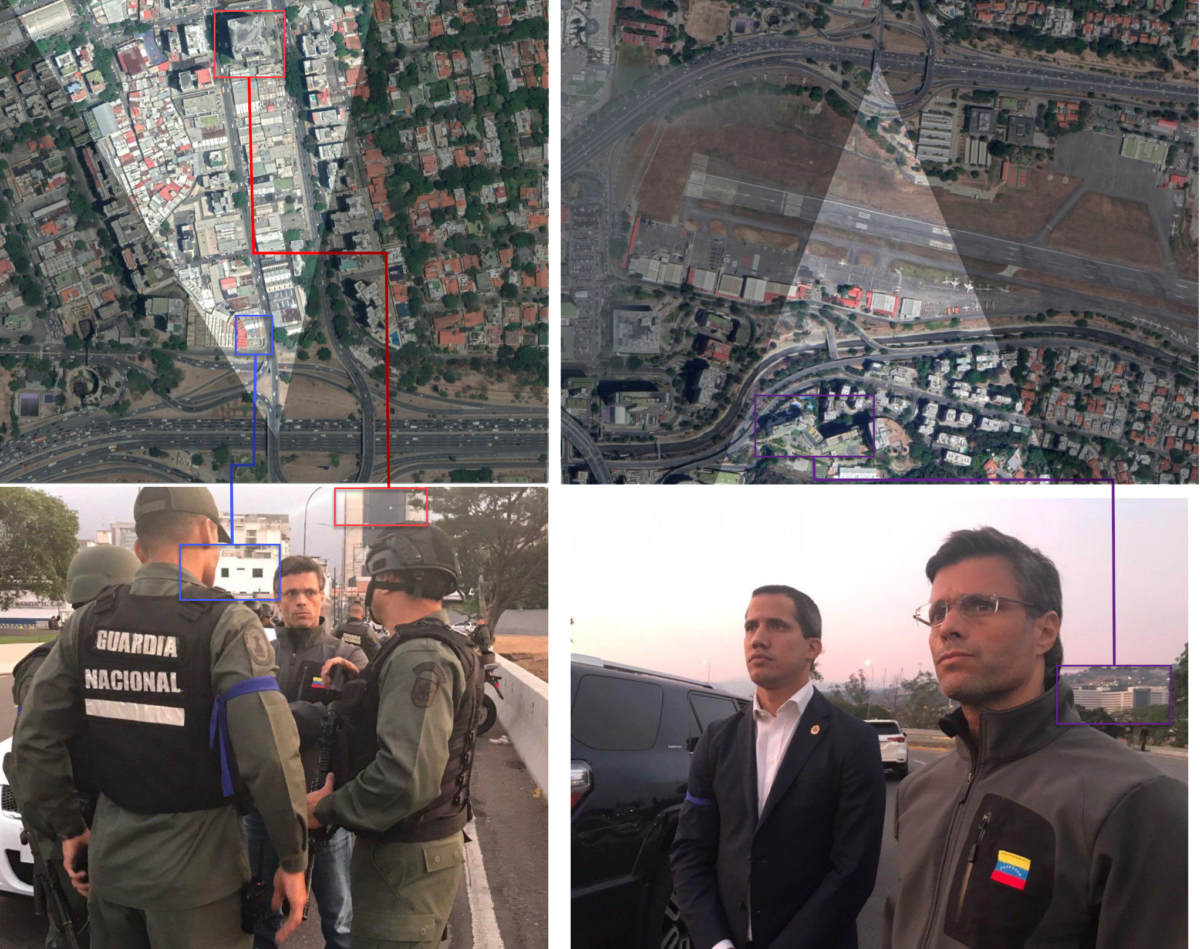
Left: Image taken on the bridge looking north towards Altamira. Right: Image looking south, across La Carlota air base. Satellite image courtesy Google/Digital Globe
López and Guaidó were joined by a group of loyal soldiers who wore blue armbands and bandanas. In the video below, two soldiers are setting up a machine gun (likely an FN MAG) on the overpass, looking east along the Francisco Fajardo highway. Someone off-screen tells the soldier with the machine gun to lower the weapon because “people will get nervous”:
llego el momento que todos los Venezolanos esperamos, asiq ue llego que el momento que todos los venezolanos apoyemos
Vamos Venezuela TODOS A LA CALLE a apoyar al Presidenre Juan Guaido
–#FelizMartes La Carlota #30Abr Golpe de Estado Distribuidor Altamira Francisco Fajardo pic.twitter.com/up8Kl8Teh8— AnonyNews VenezuelaLibre ?☠️ ??☠️ (@AnonyNews666) April 30, 2019
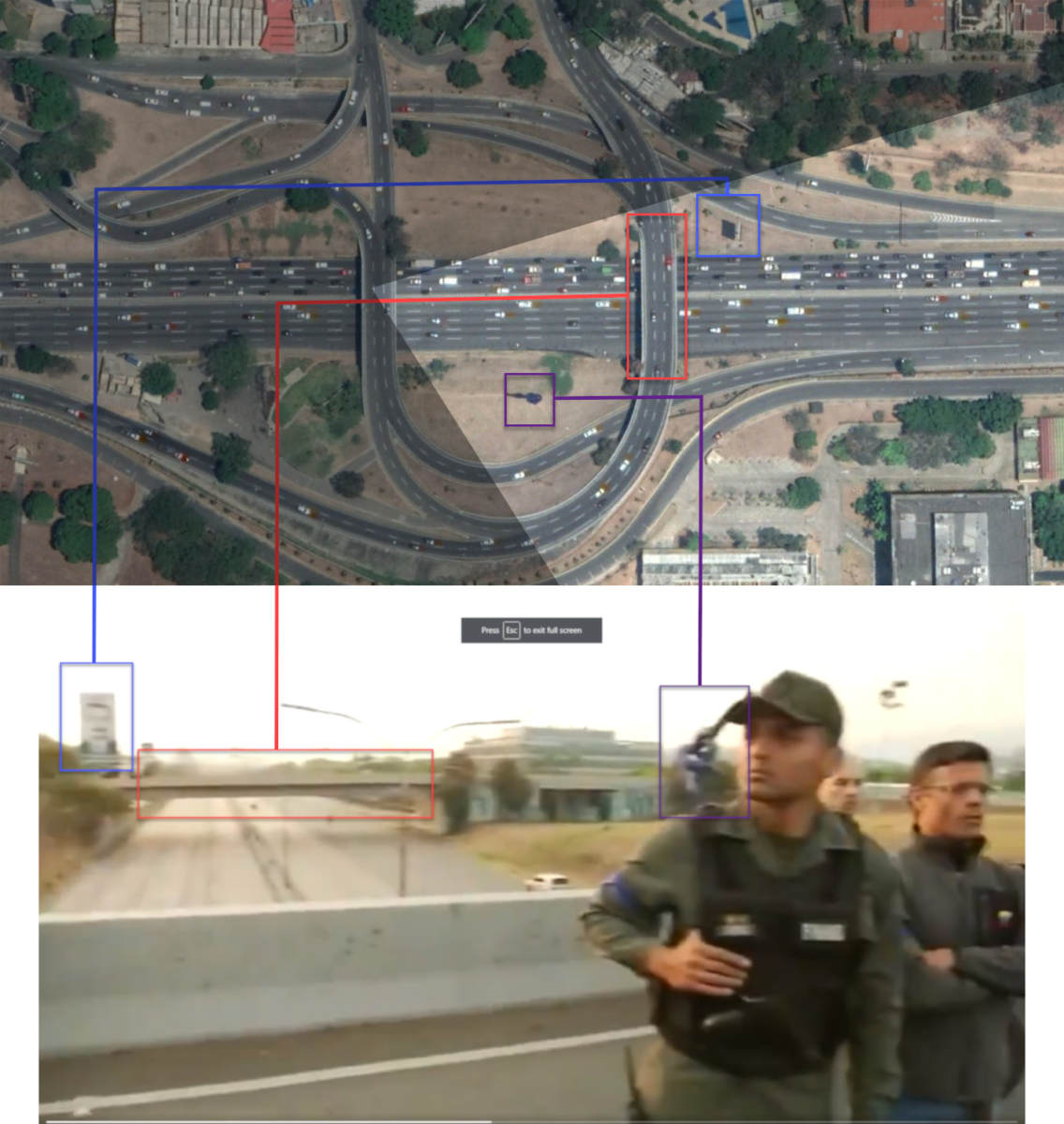
Still image from the machine gun video, looking east along the Francisco Fajardo highway. Satellite image courtesy Google/Digital Globe
The situation on the overpass devolved into chaos when, at approximately 8:30 a.m., gunfire erupted. The moment was captured on video by Noticias Caracol, a Colombian news outlet, as seen in the bottom tweet below:
Noticias Caracol transmite, en vivo desde Caracas, impresionantes imágenes que dan cuenta de los enfrentamientos entre las fuerzas opositoras y los grupos leales a Maduro. Siga, minuto a minuto, nuestra cobertura en https://t.co/yqNEZK7rZ3 >>> pic.twitter.com/w3SjbkZBpT
— Noticias Caracol (@NoticiasCaracol) April 30, 2019
Part of the shooting was also captured on video by a journalist on the overpass. The video from the overpass captured protesters ducking for cover and rebel soldiers shooting their weapons into the air:
Based on the open source evidence currently available, it is not possible to determine what triggered the shooting. The journalist in the video above claims that the overpass was taking fire from government forces inside La Carlota. It is plausible that nervous soldiers on the overpass may have started shooting in response to a perceived, thought perhaps non-existent threat.
A relative calm eventually returned to the overpass, and by mid-morning the crowd in the area was in the hundreds.
Throughout the rest of the morning, protesters made repeated attempts to breach the perimeter fence at La Carlota. Some of those attempts were captured by a live camera that broadcast the confrontations between protesters and the authorities on the Francisco Fajardo highway throughout much of the morning.
This camera also captured the moment that a National Guard Norinco VN-4 armoured vehicle drove into a group of protesters. Below, a clip from the live stream showing the event:
The approximate location of the armoured vehicles shortly before they charged at the protesters can be seen below:
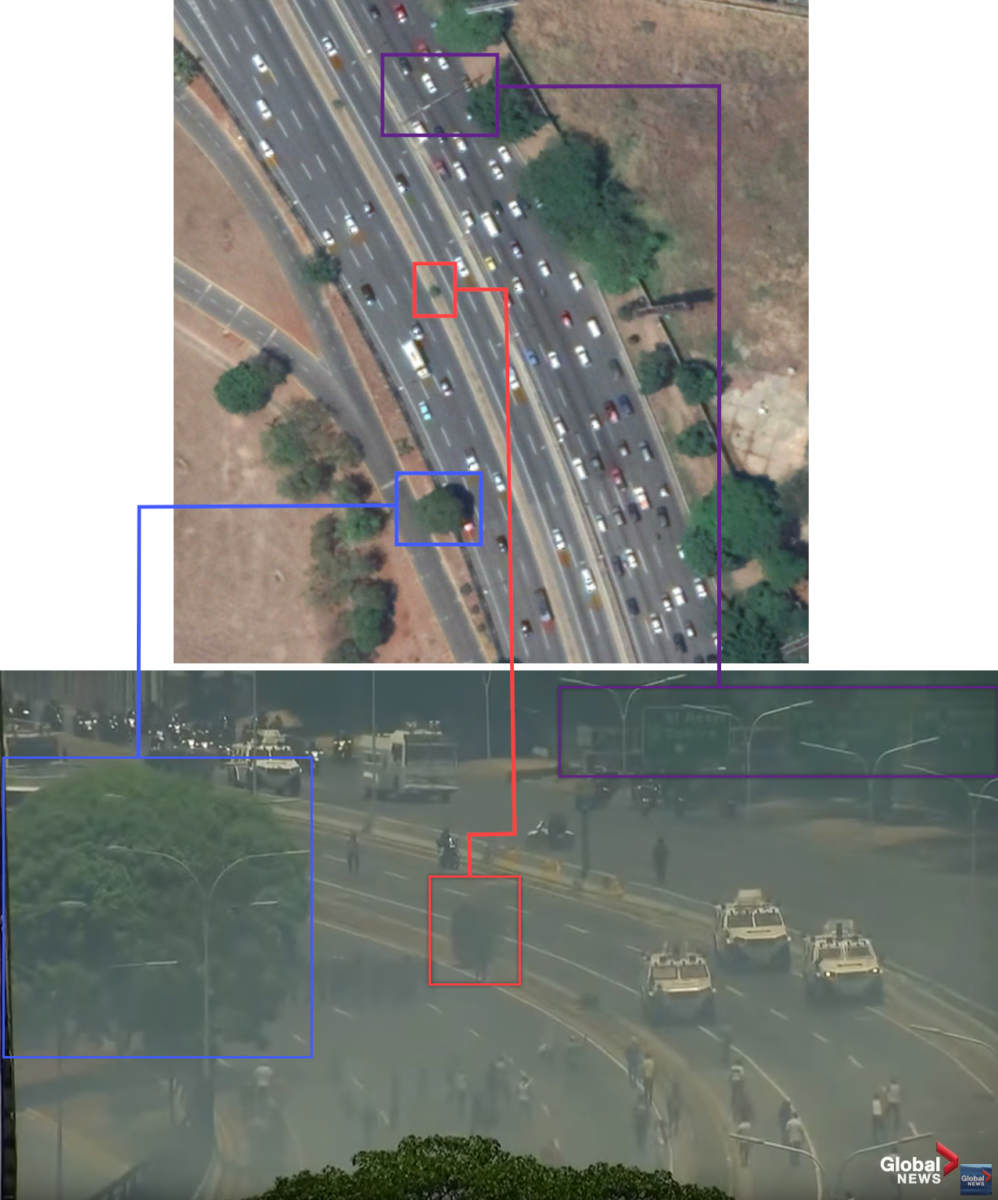
An image taken from the live camera on the Francisco Fajardo highway showing the trucks approximately three minutes before the incident. Satellite image courtesy Google/Digital Globe
At least one protester was seriously injured in the incident.
At The Ministry Of Transportation
As confrontations between the authorities and determined protesters persisted into the noon hour on the Francisco Fajardo highway, the main opposition concentration moved north to the Plaza Francia, located some 500 meters from the Altamira overpass. There, they were met by Guaidó and López. Guaidó spoke to the crowd and gave them instructions on their next move: a march westward along the Francisco de Miranda avenue.
While it never became clear exactly where the march was headed, the fact that it was moving west was significant because the western side of Caracas houses an important number of government buildings, including Maduro’s seat of power, the Miraflores Palace.
Historically, the opposition has not organized marches to the Miraflores Palace given the significance that the building has to the country’s political system. Former president Hugo Chávez was briefly ousted from power in April 2002 following an opposition march to the Miraflores Palace that left nineteen people dead.
By the noon hour, a large number of protesters were moving west from the Plaza Francia along the Francisco de Miranda avenue:
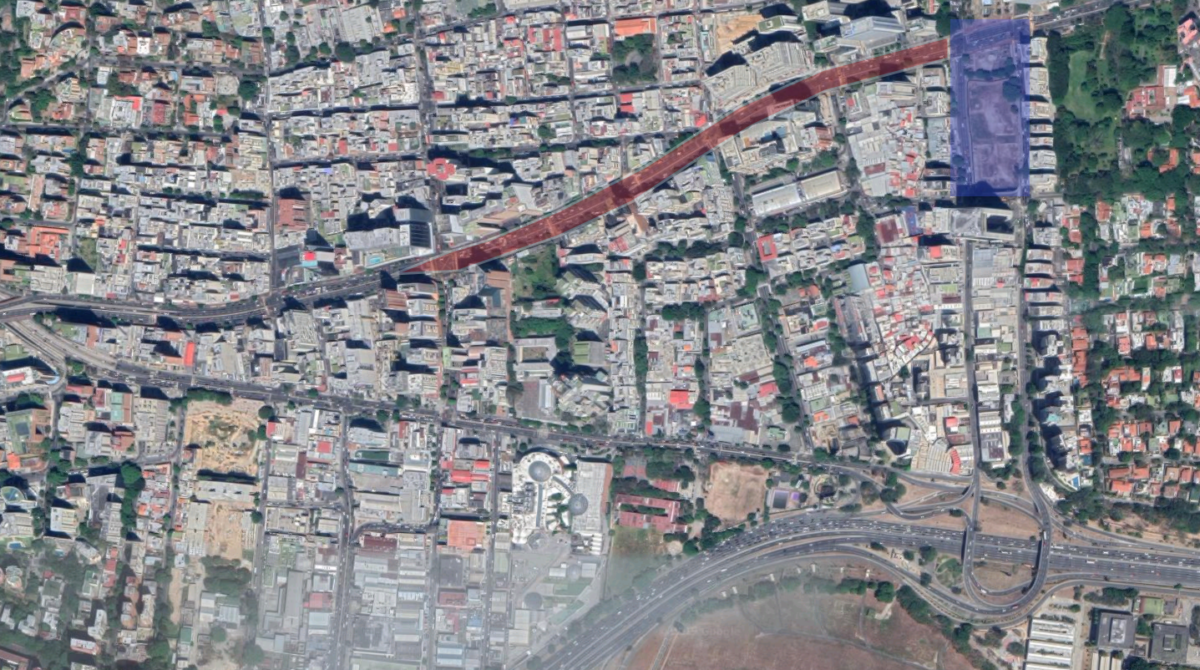
The Plaza Francia is highlighted in blue. The protesters moved west on the Francisco de Miranda avenue, highlighted in red. Satellite imagery courtesy of Google/Digital Globe
The protesters were joined by at least one group of armed rebel National Guard soldiers, seen in the video below:
#Caracas | La marcha continúa su rumbo hacia el Oeste de Caracas, siendo escoltada por militares con armas largas. Juan Guaidó y Leopoldo López también forman parte de la movilización. pic.twitter.com/OBABjwFH51
— Francisco Marín (@franciscoamarin) April 30, 2019
On their march, the protesters were confronted by a group of pro-government armed civilians known in Venezuela as a colectivo armado (“armed group” or “armed collective”). Colectivos armados play an important role in the Maduro government’s machinery of repression, since they generally act without institutional restraints faced by official state authorities like the National Guard or the National Bolivarian Police. They also provide the government plausible deniability in cases of protest-related violence.
At approximately 2:00 p.m., the group opened fire on protesters from the parking lot ramp of a building:
[#VIDEO] Colectivos fueron grabados disparando desde el Ministerio del Transporte en la avenida Francisco de Miranda en Chacao este #30Abr pic.twitter.com/x1eJXaATG2
— NTN24 Venezuela (@NTN24ve) April 30, 2019
A crew with the Colombian news channel NTN24 recorded part of the police operation to clear out the colectivo armado from the area. In the video (longer version found here), Miranda State Police (in light blue) fire into the parking lot in which the armed individuals were taking cover. The police are joined by officers from the Chacao Municipal Police (in light green):
#URGENTE Policía de Miranda se enfrenta a colectivos que dispararon contra las personas desde dentro del Ministerio del Transporte en Chacao #30Abr (Vía @luisgonzaloprz) https://t.co/O1QP0VqoTT pic.twitter.com/9VaxgqFWEm
— NTN24 Venezuela (@NTN24ve) April 30, 2019
A video recorded the same day by an NTN24 crew at the intersection of Elice street and the Francisco de Miranda avenue provides details for geolocating the spot from which the colectivo armado fired on the protesters. At the start of the video, the camera is looking north along Elice street. As the video progresses, the camera pans west, along Francsico de Miranda avenue:
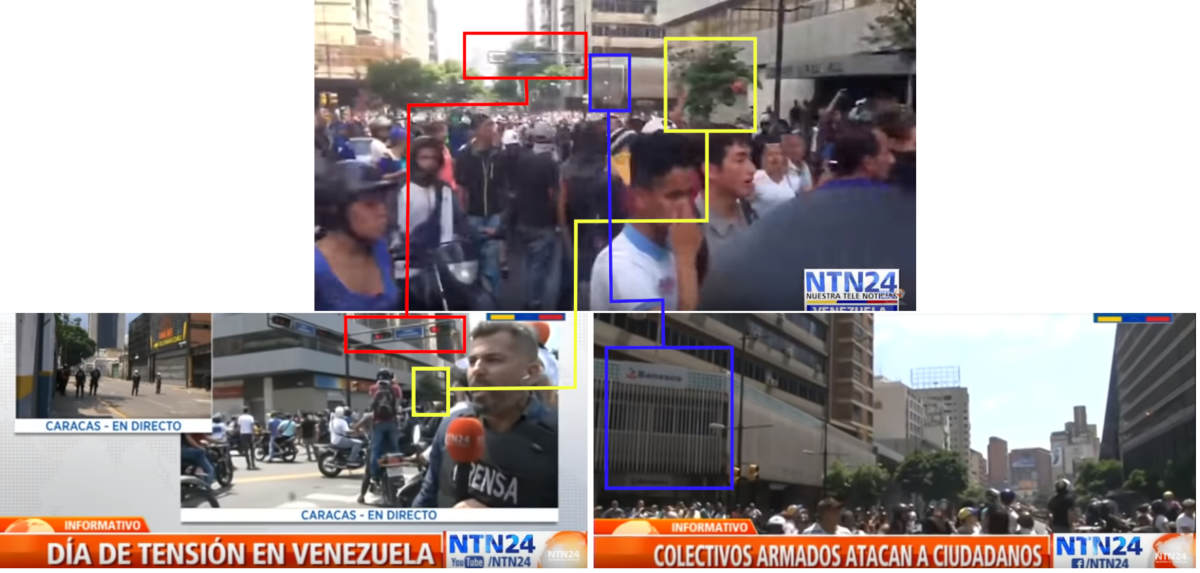
Top: A still from the NTN24 footage showing the parking lot entrance used by the colectivo armado, looking south towards the intersection. Below, left and right: Stills from the NTN24 crew footage at the intersection of the Francisco de Miranda avenue and Elice street
Based on these two videos from NTN24, it is possible to determine that the colectivo armado members were shooting from a parking lot entrance to the Torre MTT, a building located on Elice street, just north of the intersection with the Francisco de Miranda avenue:
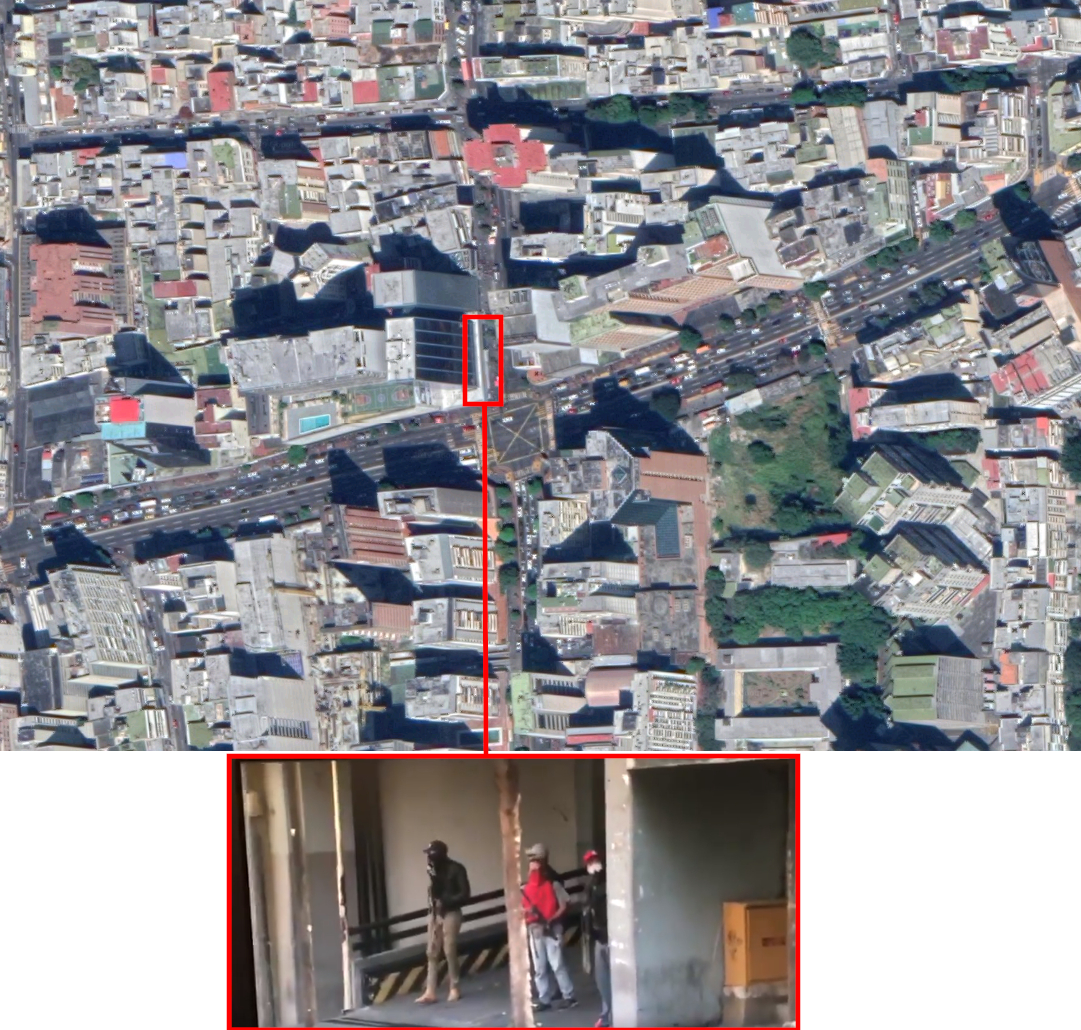
The location of the entrance to the parking lot entrance on Elice street where the colectivo armado was located is highlighted above. The building houses the offices of the Ministry of Transportation (Ministerio del Poder Popular para el Transporte, MPPT). Satellite imagery courtesy of Google/Digital Globe
El Nacional reported that one person was injured by shots fired by the colectivo. El Pitazo, another Venezuelan news outlet, reported that eight police officers who participated in the shootout were subsequently asked by their superiors to hand over their service weapons, and informed that their actions would be the subject of an investigation by a police oversight body.
By the mid-afternoon, the protesters’ march westward had been halted by National Guard soldiers who blocked their path along the Francisco de Miranda avenue. The lack of a clear destination combined with reports that Leopoldo López and his family had taken refuge in the Chilean embassy resulted in the gradual dissolution of the crowd on the avenue. By nightfall, all but a handful of determined protesters remained of the large group that left the Plaza Francia hours earlier.
Aftermath And Analysis
The events of April 30 took Venezuela by surprise. The country had been holding its breath for May 1, which Guaidó hoped would see “the largest protest ever… in the history” of the country. As Guaidó himself put it in the morning of April 30, “May 1 arrived today.”
By the end of the day on April 30, a 24-year-old named Samuel Méndez was dead, killed during a protest in La Victoria, Aragua state. His body was covered with a Venezuelan flag and carried down the street by other protesters singing the national anthem. At least 59 others were injured during the day’s unrest.
A Venezuelan journalist named Luz Mely Reyes provided a plausible account for the events of April 30. According to Reyes, the opposition was planning to issue the call for a final uprising against the government with the goal of forcing Maduro to resign. This event had been planned for another day. However, the opposition leadership saw itself forced to issue the call prematurely because it believed that Guaidó’s arrest was imminent. Feeling cornered, the opposition set into motion a plan that was not yet fully developed, and allies inside the Maduro government — including members of the armed forces — that had pledged support for opposition backed out when they heard that the plan was being deployed early.
The events of April 30 were followed by more nationwide unrest on May 1. Spurred by the lingering emotion of the day before, protesters clashed with authorities in major cities around Venezuela, leaving a 27-year-old woman named Jurubith Rausseo Garcia dead. Rausseo was shot in the head while attending an opposition protest in the Altamira neighbourhood of Caracas, and died at the El Avila hospital.
During an event in Caracas on May 1, Maduro declared victory over the latest attack against his government. Speaking about the opposition figures who a day earlier had tried to remove him from power, Maduro said:
Justice is looking for them, and sooner or later they will go to jail to pay for their treason and their crimes.
Given the level of support that Guaidó enjoys both inside Venezuela and among western countries, including the United States, it is likely that the Maduro government will continue to be hesitant to make any direct move against Guaidó out of fear that his detention could spark a larger conflict, possibly involving foreign powers.
The fallout from the events of the last 48 hours has yet to settle. While the crisis appears to be reverting into the same pattern that has dominated its dynamic since January 23 of this year, the events of April 30 are evidence that powerful currents run beneath what may otherwise appear to be a stalemate. It is only a matter of time before these currents surge to the surface yet again.
